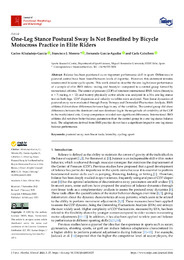Please use this identifier to cite or link to this item:
https://hdl.handle.net/11000/34268Full metadata record
| DC Field | Value | Language |
|---|---|---|
| dc.contributor.author | Caballero, Carla | - |
| dc.contributor.author | Moreno, Francisco Javier | - |
| dc.contributor.author | Albaladejo García, Carlos | - |
| dc.contributor.author | García Aguilar, Fernando | - |
| dc.contributor.other | Departamentos de la UMH::Ciencias del Deporte | es_ES |
| dc.date.accessioned | 2025-01-10T09:46:21Z | - |
| dc.date.available | 2025-01-10T09:46:21Z | - |
| dc.date.created | 2023 | - |
| dc.identifier.citation | Journal of Functional Morphology and Kinesiology | es_ES |
| dc.identifier.issn | 2411-5142 | - |
| dc.identifier.uri | https://hdl.handle.net/11000/34268 | - |
| dc.description.abstract | Balance has been positioned as an important performance skill in sport. Differences in postural control have been found between levels of expertise. However, this statement remains unanswered in some cyclic sports. This work aimed to describe the one-leg balance performance of a sample of elite BMX riders—racing and freestyle—compared to a control group formed by recreational athletes. The center of pressure (COP) of nineteen international BMX riders (freestyle, n = 7; racing, n = 12) and twenty physically active adults was analyzed in a 30-s one-leg stance test on both legs. COP dispersion and velocity variables were analyzed. Non-linear dynamics of postural sway were evaluated through Fuzzy Entropy and Detrended Fluctuation Analysis. BMX athletes did not show differences between legs in any of the variables. The control group did show differences between the dominant and non-dominant leg in the magnitude of variability of the COP in the mediolateral axis. Group comparison revealed non-significant differences. International BMX athletes did not show better balance parameters than the control group in a one-leg stance balance task. The adaptations derived from BMX practice do not have a significant impact in one-leg stance balance performance. | es_ES |
| dc.format | application/pdf | es_ES |
| dc.format.extent | 10 | es_ES |
| dc.language.iso | eng | es_ES |
| dc.publisher | MDPI | es_ES |
| dc.relation.ispartofseries | 8 | es_ES |
| dc.relation.ispartofseries | 1 | es_ES |
| dc.rights | info:eu-repo/semantics/openAccess | es_ES |
| dc.rights | Attribution-NonCommercial-NoDerivatives 4.0 Internacional | * |
| dc.rights.uri | http://creativecommons.org/licenses/by-nc-nd/4.0/ | * |
| dc.subject | postural sway | es_ES |
| dc.subject | non-linear tools | es_ES |
| dc.subject | laterality | es_ES |
| dc.subject | cycling | es_ES |
| dc.subject | sport | es_ES |
| dc.subject.other | CDU::7 - Bellas artes::79 - Diversiones. Espectáculos. Cine. Teatro. Danza. Juegos.Deportes | es_ES |
| dc.title | One-Leg Stance Postural Sway Is Not Benefited by Bicycle Motocross Practice in Elite Riders | es_ES |
| dc.type | info:eu-repo/semantics/article | es_ES |
| dc.relation.publisherversion | https://doi.org/ 10.3390/jfmk8010025 | es_ES |

View/Open:
2023_JCR_23_JFMK_One-Leg Stance Postural Sway Is Not Benefited by Bicycle.pdf
582,93 kB
Adobe PDF
Share:
.png)
